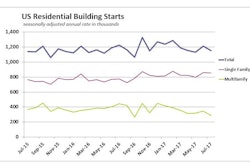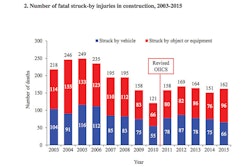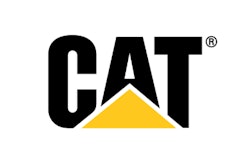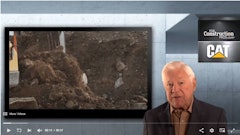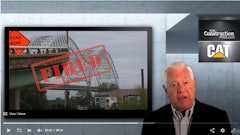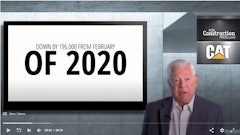Construction News Tracker is presented by Caterpillar and produced by ForConstrucitonPros.com.
In an effort to jump start the nation's infrastructure program, President Trump has rolled back rules regarding environmental reviews and restrictions in flood prone building projects. Signing the executive order eliminates the Obama-era program aimed at reducing exposure to flooding sea level rise and other climate change effects regarding infrastructure. The move streamlines the road building process nationwide by slashing road building timeline from seven years down to two.
The pace of single family housing construction starts in the U.S. was effectively flat in July after strong June growth, but multifamily starts plunged 17% dragging total starts down 4.8% to a 1.2 million seasonally adjusted annual rate. Year to date, however, single family starts are up almost 9% compared to the same period of 2016. The National Association of Home Builders analysis of the monthly Commerce Department data calls this right in line with its forecasts for modest single family growth this year and multifamily construction declining to a more sustainable rate.
U.S. Census Bureau data indicates government spending on transportation and other public works projects in the second quarter of 2017 is just 1.4% of the nation's economic output, the lowest on record. And there's no relief in sight as federal funding stagnates while both state and local governments tighten their spending belts. Contractors are hunting for infrastructure jobs. The report claims in 34 states spending was lower last year than in 2007 adjusting for inflation. The Census report claims public construction was 9.5% lower in June than a year ago. AGC Chief Economist Ken Simonson reports many states are in a financial struggle due to the federal cutback.
A per mile driver charge system that could one day supplement or even replace the nation's federal gas tax for highway projects will be tested in an I-95 program next year. The three-month effort by the East Coast Transportation Corridor Coalition in Pennsylvania and Deleware will be supervised by CH2M Hill. It’ll cost $1.16 million and educate drivers on gas taxes and infrastructure financing options. The program will echo one now in Oregon where drivers pay one and a half cents per mile in lieu of state gas taxes in a voluntary effort.
In an effort to expand its government and infrastructure portfolio Jacobs Engineering Group of Dallas is poised to buy out CH2M Hill for $2.85 billion. The Wall Street Journal report claims the deal would grow to $3.27 billion if Jacobs assumes CH2M Hill debts of $416 million. Three quarters of Hill's business is in North America with 20,000 employees. There is speculation Jacobs is positioning itself to take advantage of an anticipated massive federal infrastructure spending program.
Contractors know full well the meaning of struck-by accidents of its employees on jobsites. And it's no myth. The Center for Construction Research and Training reports there were over 800 construction related fatalities between 2011 and 2015. That’s more than any other American industry. Fifty-two percent of the deaths were the result of workers being hit by objects or equipment, and the remainder by construction site vehicles. And, 57% of the vehicle hits occurred in work zones with the majority of those on highway maintenance projects.
Many states would like to be facing the issue of how to hire 1,000 transportation workers, but that’s whats happening in California. After the legislature passed and the governor signed the massive $5 billion transportation bill earlier this year Caltrans is poised to hire an additional 1,000 employees well before the funding takes effect in November. The 12 cent per gallon gas tax increase is expected to raise $52 billion in the state over the next 10 years.
Many municipalities could improve their situations by following an Atlanta program initiated some 10 years ago, but rarely publicized. Called TRIP, the Towing and Recovery Incentive Program pays out a bonus of $2,500 dollars to heavy-duty towing and recovery operators who can clear wreckage from an interstate highway in 90 minutes or less. Its primarily used to clear tractor trailers from Atlanta area interstates following wrecks. The Georgia DOT program has paid out over $2 million for 912 TRIP activations since 2008. TRIP has managed to cut wreckage removal times from 216 minutes to less than 90 minutes average.
In closing, the high cost of living hasn't affected its popularity.
This is Construction News Tracker looking over the industry that makes the world a better place, presented by Caterpillar and produced by ForConstructionPros.com.
Follow us on social media at YouTube, Facebook and Twitter using #constructionnews as the streaming Web never ends.




